|
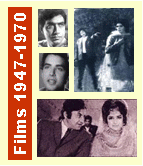 Film and Cinema in Pakistan are not very old. At the time of independence, there was no cinema in Karachi and it was in September 1947, that Jubilee cinema was
inaugurated in Karachi and thus became the first Pakistani cinema.
Thereafter, the film industry thrived, and so did the cinemas. Film and Cinema in Pakistan are not very old. At the time of independence, there was no cinema in Karachi and it was in September 1947, that Jubilee cinema was
inaugurated in Karachi and thus became the first Pakistani cinema.
Thereafter, the film industry thrived, and so did the cinemas.
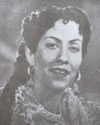 Initially, only Indian films were screened till "Teri Yaad" which became the first Pakistani film
was screened at Parbharat (later Sanobar) cinema in Lahore on 8 August 1948, starring Nasir Khan (Dilip Kumar’s brother) and Asha Posley.
"Phairay" a Panjabi film was the first Pakistani silver jubilee film. Initially, only Indian films were screened till "Teri Yaad" which became the first Pakistani film
was screened at Parbharat (later Sanobar) cinema in Lahore on 8 August 1948, starring Nasir Khan (Dilip Kumar’s brother) and Asha Posley.
"Phairay" a Panjabi film was the first Pakistani silver jubilee film.
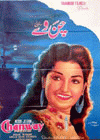 The females also stepped into the direction and Noor Jehan , who later rose to the heights of fame as a singer, became the first Pakistani women to direct "Chan way (1951)"
- the movie with the famous song "Way mundia
sialkotia". After Phairay, "Sassi"(1954) became the first Pakistani Golden Jubilee (over 50 weeks) film. Gul Bakawli was the first Pakistani film to have coloured songs. In April 1964, "Sangam" became the first Pakistani full-length colour movie.
"Bahana" made its debut as the first black & white cinemascope film (1965), while "Mala" was the first Pakistani colour cinemascope film. The females also stepped into the direction and Noor Jehan , who later rose to the heights of fame as a singer, became the first Pakistani women to direct "Chan way (1951)"
- the movie with the famous song "Way mundia
sialkotia". After Phairay, "Sassi"(1954) became the first Pakistani Golden Jubilee (over 50 weeks) film. Gul Bakawli was the first Pakistani film to have coloured songs. In April 1964, "Sangam" became the first Pakistani full-length colour movie.
"Bahana" made its debut as the first black & white cinemascope film (1965), while "Mala" was the first Pakistani colour cinemascope film.
 Then in 1966 came the unforgettable and memorable "Arman" starring Waheed Murad and Zeba that turned out to be the first Pakistani Platinum Jubilee (over 75 weeks). Its music director was Sohail Rana, whose musical score for this film still
reverberates in the ears of the music lovers.
Then in 1966 came the unforgettable and memorable "Arman" starring Waheed Murad and Zeba that turned out to be the first Pakistani Platinum Jubilee (over 75 weeks). Its music director was Sohail Rana, whose musical score for this film still
reverberates in the ears of the music lovers.
 The end of 60s
also saw Riaz Shahid rising to the occasion, soon after the Israeli
occupation of Jerusalem in 1967 Arab Israel war, and made "Zarqa", with Nelo
as the lead heroine and Ejaz. Soon thereafter, he made another equally
captivating film "Yeh Amn" based on the Kashmiri struggle for their
independence from the yoke of the Indian occupation. The end of 60s
also saw Riaz Shahid rising to the occasion, soon after the Israeli
occupation of Jerusalem in 1967 Arab Israel war, and made "Zarqa", with Nelo
as the lead heroine and Ejaz. Soon thereafter, he made another equally
captivating film "Yeh Amn" based on the Kashmiri struggle for their
independence from the yoke of the Indian occupation. |
 In 1971, "Dosti" remained on the screen for over 100 weeks and thus became the first Pakistani Diamond Jubilee. However, till date no film has been able to match the record 400 weeks (well over 4 years) by Nadeem and Shabnam's "Aina". In 1971, "Dosti" remained on the screen for over 100 weeks and thus became the first Pakistani Diamond Jubilee. However, till date no film has been able to match the record 400 weeks (well over 4 years) by Nadeem and Shabnam's "Aina".
There have been many films thereafter, but very few could leave impressive imprints and cinema goers even today would prefer to watch old Pakistani films, which were original, melodious and pure
family movies.  One
such Punjabi film "Heer Ranjha" will be remembered for decades for its
beautiful music, photography and directions, besides acting by the lead
faces like Ejaz and Firdous. The mood of films changed - from family movies to violence, specially in Pushto and Punjabi films. One
such Punjabi film "Heer Ranjha" will be remembered for decades for its
beautiful music, photography and directions, besides acting by the lead
faces like Ejaz and Firdous. The mood of films changed - from family movies to violence, specially in Pushto and Punjabi films.
 Sultan Rahi and Mustafa Qureshi became instant heroes of so called action films from early 70s. Films like "Wahshi Jat" followed by "Maula Jat" changed the mood of punjabi films. Sultan Rahi and Mustafa Qureshi became instant heroes of so called action films from early 70s. Films like "Wahshi Jat" followed by "Maula Jat" changed the mood of punjabi films.

"Sher Khan and Sala Sahab" did record business and did business over 200 weeks at a stretch. "Anwara" for its "modern" dances was much liked by the
audience.
 Punjabi films
mostly revolve around village animosities and violence, though generally
blown out of proportion. Syed Noor, a talented director could also not
desist from violence in his "Choorian". Punjabi films
mostly revolve around village animosities and violence, though generally
blown out of proportion. Syed Noor, a talented director could also not
desist from violence in his "Choorian".
Female film directors like Sangeeta, Shamim Ara, Samina Peerzada and lately film actress Remma have also produced some quality movies, that include "Muthi bhar chawal, Miss Hong Kong" etc.
Lately, "Jeva, Salakhain" have been success films but a few good movies do
not make up the requirement, nor do the present films are of any match
to the golden age of "Insaniyat, Do Raha, Armaan, Andaleeb, or even early
70s Aina or Dosti".
|
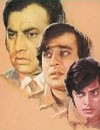 Films are the most popular entertainment both in urban and rural areas. The films and specially the TV dramas are captivating. The film industry is mainly based in Karachi and
Lahore. Though the cable network on TV has confined many to their homes, a large majority of people still prefer to watch a movie in the cinema.
However, the quality of cinema in Pakistan is witnessing a sharp decline
both in quality of story and music. Previously, most big star movies would
be on screen for months. Now such mega films are no where to be seen. Films
now focus more on violence and obscenity rather than classics and family
entertainment.
Films are the most popular entertainment both in urban and rural areas. The films and specially the TV dramas are captivating. The film industry is mainly based in Karachi and
Lahore. Though the cable network on TV has confined many to their homes, a large majority of people still prefer to watch a movie in the cinema.
However, the quality of cinema in Pakistan is witnessing a sharp decline
both in quality of story and music. Previously, most big star movies would
be on screen for months. Now such mega films are no where to be seen. Films
now focus more on violence and obscenity rather than classics and family
entertainment.
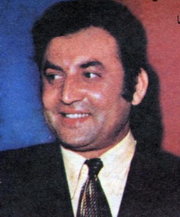 Muhammad Ali is one of those early heroes of Pakistan film industry who became instant celebrity right from their initial debut. "Shararat" and "Khamosh raho" both produced in 1964 were the first films in Muhammad Aliappeared as a hero. However some of his memorable films include "Aag Ka Darya, Kaneez, Shaheed, Insaan aur Aadmi, Insaaf aur Qanoon, Daman aur chingari, Waday ki zanjeer, and Baazi. Muhammad Ali married famous film actress Zeba, with who he performed in number of films. Presently, almost retired from film industry, the couple is living a pure homely life. On the fateful day of March 19, 2006, the legendary film star died of
prolonged illness in Lahore and laid to rest on 21 March 2006.
Muhammad Ali is one of those early heroes of Pakistan film industry who became instant celebrity right from their initial debut. "Shararat" and "Khamosh raho" both produced in 1964 were the first films in Muhammad Aliappeared as a hero. However some of his memorable films include "Aag Ka Darya, Kaneez, Shaheed, Insaan aur Aadmi, Insaaf aur Qanoon, Daman aur chingari, Waday ki zanjeer, and Baazi. Muhammad Ali married famous film actress Zeba, with who he performed in number of films. Presently, almost retired from film industry, the couple is living a pure homely life. On the fateful day of March 19, 2006, the legendary film star died of
prolonged illness in Lahore and laid to rest on 21 March 2006.  Waheed Murad - first appeared on the screen in 1961, and his boyish appearance drilled into hearts of the
audience specially the female community when he produced his ever remembering fil "Arman" with Zeba as heroine in 1966. The film was
Pakistan's first ever Platinum Jubilee film. Most of his films did golden and diamond jubilees like "Shabana, Anjuman, Kaneez, Insaniyat, Dever Bhabhi, Andleeb, Baharo Phool Barsao, Shama, Surayya Bhoopali, Doraha and many more. He was at his best with Zeba and Rani. His last film "Hero" was released two years after his death(1983) in 1985. He is still remembered as the "Chocolate Hero" for his attire, style, smartness and instantancy.
Waheed Murad - first appeared on the screen in 1961, and his boyish appearance drilled into hearts of the
audience specially the female community when he produced his ever remembering fil "Arman" with Zeba as heroine in 1966. The film was
Pakistan's first ever Platinum Jubilee film. Most of his films did golden and diamond jubilees like "Shabana, Anjuman, Kaneez, Insaniyat, Dever Bhabhi, Andleeb, Baharo Phool Barsao, Shama, Surayya Bhoopali, Doraha and many more. He was at his best with Zeba and Rani. His last film "Hero" was released two years after his death(1983) in 1985. He is still remembered as the "Chocolate Hero" for his attire, style, smartness and instantancy.
 Film and Cinema in Pakistan are not very old. At the time of independence, there was no cinema in Karachi and it was in September 1947, that Jubilee cinema was
inaugurated in Karachi and thus became the first Pakistani cinema.
Thereafter, the film industry thrived, and so did the cinemas.
Film and Cinema in Pakistan are not very old. At the time of independence, there was no cinema in Karachi and it was in September 1947, that Jubilee cinema was
inaugurated in Karachi and thus became the first Pakistani cinema.
Thereafter, the film industry thrived, and so did the cinemas.
 Initially, only Indian films were screened till "Teri Yaad" which became the first Pakistani film
was screened at Parbharat (later Sanobar) cinema in Lahore on 8 August 1948, starring Nasir Khan (Dilip Kumar’s brother) and Asha Posley.
"Phairay" a Panjabi film was the first Pakistani silver jubilee film.
Initially, only Indian films were screened till "Teri Yaad" which became the first Pakistani film
was screened at Parbharat (later Sanobar) cinema in Lahore on 8 August 1948, starring Nasir Khan (Dilip Kumar’s brother) and Asha Posley.
"Phairay" a Panjabi film was the first Pakistani silver jubilee film.
 The females also stepped into the direction and Noor Jehan , who later rose to the heights of fame as a singer, became the first Pakistani women to direct "Chan way (1951)"
- the movie with the famous song "Way mundia
sialkotia". After Phairay, "Sassi"(1954) became the first Pakistani Golden Jubilee (over 50 weeks) film. Gul Bakawli was the first Pakistani film to have coloured songs. In April 1964, "Sangam" became the first Pakistani full-length colour movie.
"Bahana" made its debut as the first black & white cinemascope film (1965), while "Mala" was the first Pakistani colour cinemascope film.
The females also stepped into the direction and Noor Jehan , who later rose to the heights of fame as a singer, became the first Pakistani women to direct "Chan way (1951)"
- the movie with the famous song "Way mundia
sialkotia". After Phairay, "Sassi"(1954) became the first Pakistani Golden Jubilee (over 50 weeks) film. Gul Bakawli was the first Pakistani film to have coloured songs. In April 1964, "Sangam" became the first Pakistani full-length colour movie.
"Bahana" made its debut as the first black & white cinemascope film (1965), while "Mala" was the first Pakistani colour cinemascope film.
 Then in 1966 came the unforgettable and memorable "Arman" starring Waheed Murad and Zeba that turned out to be the first Pakistani Platinum Jubilee (over 75 weeks). Its music director was Sohail Rana, whose musical score for this film still
reverberates in the ears of the music lovers.
Then in 1966 came the unforgettable and memorable "Arman" starring Waheed Murad and Zeba that turned out to be the first Pakistani Platinum Jubilee (over 75 weeks). Its music director was Sohail Rana, whose musical score for this film still
reverberates in the ears of the music lovers.
 The end of 60s
also saw Riaz Shahid rising to the occasion, soon after the Israeli
occupation of Jerusalem in 1967 Arab Israel war, and made "Zarqa", with Nelo
as the lead heroine and Ejaz. Soon thereafter, he made another equally
captivating film "Yeh Amn" based on the Kashmiri struggle for their
independence from the yoke of the Indian occupation.
The end of 60s
also saw Riaz Shahid rising to the occasion, soon after the Israeli
occupation of Jerusalem in 1967 Arab Israel war, and made "Zarqa", with Nelo
as the lead heroine and Ejaz. Soon thereafter, he made another equally
captivating film "Yeh Amn" based on the Kashmiri struggle for their
independence from the yoke of the Indian occupation. In 1971, "Dosti" remained on the screen for over 100 weeks and thus became the first Pakistani Diamond Jubilee. However, till date no film has been able to match the record 400 weeks (well over 4 years) by Nadeem and Shabnam's "Aina".
In 1971, "Dosti" remained on the screen for over 100 weeks and thus became the first Pakistani Diamond Jubilee. However, till date no film has been able to match the record 400 weeks (well over 4 years) by Nadeem and Shabnam's "Aina".
 One
such Punjabi film "Heer Ranjha" will be remembered for decades for its
beautiful music, photography and directions, besides acting by the lead
faces like Ejaz and Firdous. The mood of films changed - from family movies to violence, specially in Pushto and Punjabi films.
One
such Punjabi film "Heer Ranjha" will be remembered for decades for its
beautiful music, photography and directions, besides acting by the lead
faces like Ejaz and Firdous. The mood of films changed - from family movies to violence, specially in Pushto and Punjabi films.
 Sultan Rahi and Mustafa Qureshi became instant heroes of so called action films from early 70s. Films like "Wahshi Jat" followed by "Maula Jat" changed the mood of punjabi films.
Sultan Rahi and Mustafa Qureshi became instant heroes of so called action films from early 70s. Films like "Wahshi Jat" followed by "Maula Jat" changed the mood of punjabi films.

 Punjabi films
mostly revolve around village animosities and violence, though generally
blown out of proportion. Syed Noor, a talented director could also not
desist from violence in his "Choorian".
Punjabi films
mostly revolve around village animosities and violence, though generally
blown out of proportion. Syed Noor, a talented director could also not
desist from violence in his "Choorian".

